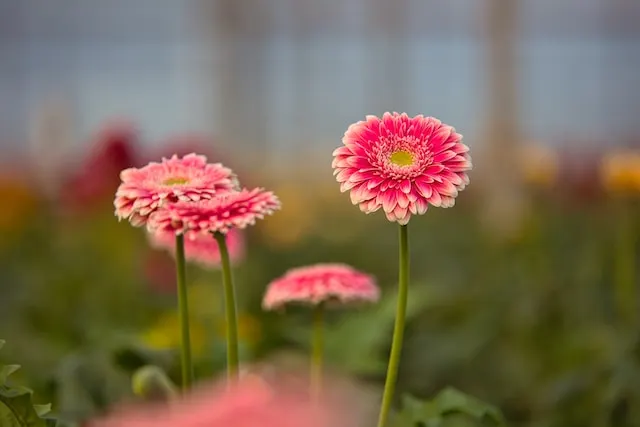If you are a farmer who is willing to setup a gerbera farm & cultivate gerbera, then this article is definitely for you. By reading this ultimate article on gerbera farming you can learn: benefits of cultivating gerbera, climate, soil, soil treatment process, bed preparation, polyhouse setup, fertilizers, irrigation, etc.
You will also get to know various subsidies offered by the respective governments, present market price, post harvest handling, etc. These things will help you in getting higher yield, planning better marketing strategies & achieving higher returns.
Table of Contents
Introduction
Gerbera is a popular and versatile flower that is highly valued in the horticulture industry for its aesthetic appeal & commercial value. They have a rosette of dark green, glossy leaves that arise from the base. The leaves are lobed or deeply toothed and have a soft texture. The plant forms a compact clump with multiple stems that can reach a height of around 30 to 60 centimeters.
But, the most amazing feature of the this flowering plant is its large, daisy-like flowers. The flowers are typically 7 to 12 centimeters in diameter & come in a wide range of colors, including red, orange, yellow, pink, and white.
Cut flowers of gerbera are in high demand due to their vibrant colors, long vase life and use in various floral arrangements. Apart from their use in floral arrangements, gerbera flowers are often used in weddings, special events, and decorations. Industries use gerbera to prepare natural dyes and the blooms in the cosmetic industry for their skin benefits.
However, to get maximum output & reduce losses, farmers should opt for polyhouse gerbera cultivation. Initial investments are slightly higher, but in long term it helps in getting optimum yield, protection from pests and diseases, and extended growing seasons.
Origin Of Gerbera
The actual origin of gerbera is still not clear but botanist believe that it originated in South Africa. However, the name of this plant is derived from 18th century German naturalist, Traugott Gerbera.
Gerbera Farming Guide

Let’s start with basic step, which is understanding requirements for cultivating gerbera.
Climate & Temperature
Gerbera can be cultivated in moderate climatic conditions where day temeperature ranges from 22 to 25o Celsius & night temperature from 12 to 16o Celsius. Humidity should be around 60% & they like to grow well in bright indirect sunlight. That’s why use shade nets for polyhouse that can cut 50% of the light intensity.
Soil
Well drained soils rich in organic matter with pH around 5.5 to 7.0 are considered ideal for gerbera plantation. If your site has red lateritic soil, then you can easily cultivate this flower crop. Moreover, make sure that soil salinity is less than 1 ms per centimetre.
Soil Sterilization
Gerbera crop is prone to fungal diseases caused by soil borne pathogens such as Phytophthora, Fusarium & Pythium. Hence before plantation, treat your soil using solar, steam or chemical sterilization methods. Out of these 3 methods chemical method of soil sterilization is found to be most effective.
How To Practice Soil Solar Sterilization?
After irrigating lightly, cover the soil area that has to be used for plantation with a clear polyethylene film. Leave it exposed under sunlight for 6 to 8 weeks. Trapped heat inside will kill most of the fungus.
How To Practice Soil Steam Sterilization?
In open farms or polyhouses, you can sterilize soil with the help of steam. With the help of an autoclave you can apply pressurized steam at 121o Celsius on soil to kill soil borne pathogens. However, it requires technical skills.
How To Practice Soil Chemical Sterilization?
You can practice chemical sterilization of the soil by using Formaldehyde or Dazomet or Hydrogen peroxide (H2O2) with silver. The best method is to use Hydrogen peroxide with silver to sterilize soil. Take 35 ml of Hydrogen peroxide with silver & mix it in a litre of water for per square metre area.
Irrigate the area to be sterilized with water, and then fumigate with the prepared solution. Wait for at least 5 to 6 hours after application of chemicals for planting gerbera.
You can also fumigate with 100 ml of Formaldehyde in a liter of water for per metre square area or use 30 grams of Dazomet instead of 100 ml of Formaldehyde to sterilize soil chemically. After fumigating with Formaldehyde or Dazomet, cover the soil with polythene sheet and leave it for 2 to 3 days before plantation.
Field Preparation & Growing Media
Plough the field 2 to 3 times and bring it to a fine tilth. Next step is to prepare growing media by mixing Farm Yard Manure, river sand & rice husk or cocopeat in ratio 2:1:1. With the help of this media prepare raised beds of 1 to 2 metres width & 30 centimetres height. Distance between two beds should also be 30 centimetres.
Using prepared growing media for preparing beds are necessary for getting good bud formation, flower diameter, flower stalk length, flower weight, number of
flowers perplant, etc.
Before plantation you should mix 2.5 tonnes of Neem cake fertilizer per hectare, 0.5 Kilogram Magnesium sulphate per 100 square feet & 400 grams Phosphorus per 100 square feet in the prepared bed.
Propagation Of Gerbera
You can propagate gerbera easily by division of clumps (suckers) or you can use tissue cultured plants directly from the market.
To propagate gerbera through division, divide the root clump of an established gerbera plant. Gently separate the clump into smaller sections, ensuring that each division has a portion of the root system and several healthy shoots or buds. Replant the divisions in well-prepared soil, keeping them at the same depth as before. Irrigate thoroughly after planting.
Plantation Time & Spacing
You can cultivate gerbera in a polyhouse anytime in a year but the best planting seasons are January to March & June to August. Spacing between plant to plant should be 30×30 or 30×40 centimetres for best outcome. Keep the crown 1 to 2 centimeters above ground level.
Irrigation
You will have to install drip irrigation system for best outcomes. Once after every 2 to 3 days apply 3.5 litre/drip/plant for 20 minutes. A single gerbera plant requires 500 to 600 ml of water everyday. However, under traditional farming condition, such as not using a polyhouse under open air, irrigation frequency depend on soil type, climatic conditions, etc.
Fertilizers
If you have installed drip irrigation system, then you can practice fertigation to fertilize gerbera plants in your farm. It gives best results and reduces wastage of fertilizers. Follow this recommendation by Tamil Nadu Agriculture University to fertigate your farm:
| A Tank Fertilizers (Monday) | Quantity (g/500m2) |
|---|---|
| Calcium Nitrate | 700 |
| Fe EDTA / sulphate | 20 |
| Pottasium Nitrate ( 13:0:46) | 400 |
| B Tank Fertilizers (Tuesday, Thursday, Saturday) | Quantity (g/500m2) |
|---|---|
| Mono Ammonium Phosphate (12:61:0) | 300 |
| Sulphate of Potash (0:0:50) | 700 |
| Magnesium Sulphate | 700 |
| Manganese Sulphate | 5 |
| Zinc Sulphate | 3 |
| Copper Sulphate | 3 |
| Borax | 3 |
| Molybdenum (Sodium Molybdate) | 1 |
If you do not have drip system installed, then you can apply 8 Kilograms of Farm Yard Manure per metre square & 250 grams of NPK (12:32:16) per metre square every month.
Interculture Operations
Weeding & Raking: Keep removing weeds with the help of hand or hoe to promote good health of the plant. Raking soil once after every 15 days is eqaully important to improve aeration & water infilteration.
Pruning & Disbudding: Keep removing old and diseased leaves time to time and flowers buds till 2 months after plantation. They allow buds to grow for getting good flower size and weight.
Pests & Diseases
Gerbera plants can get affected due to variety of pests such as aphids, mealybugs, whitefly, thrips, spider mites, leaf miner, snails, etc. Follow these guidelines to control them.
| Pests | Control Methods |
|---|---|
| Aphids | Apply Dimethoate 30 EC 2 ml per litre of water |
| Thrips | Apply Fipronil 2 ml per litre of water |
| Whiteflies | Spray Imidacloprid 17.8 % SL 2 ml per litre of water |
| Red Spider mites | Spray Propargite 1 ml per litre of water |
| Nematodes | Apply Bacillus subtilis (BbV 57) 2.5 Kilograms per hectare |
Moreover, diseases such as powdery mildew, flower bud rot, leaf rot and crown rot. In case of powdery mildew spray wettable Sulphur 2 grams per litre of water. You can treat flower bud rot by spraying copper oxychloride 2 grams per litre.
Harvesting Of Gerbera
You can start harvesting gerbera when flowers are completely open. Plant starts flowering 3 months after plantation. The ideal time to harvest is early morning when the flowers are cool and well-hydrated. Choose a stem that has a healthy flower, and follow it down to the base where it meets the foliage. Cut the stem just above the foliage, making a clean diagonal cut.





